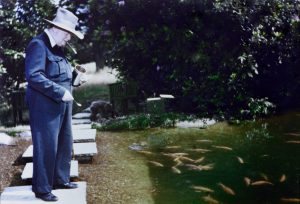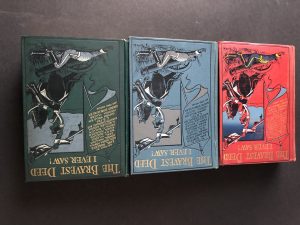
Finest Hour 183
Watching Winston: Churchill and His Personal Bodyguards
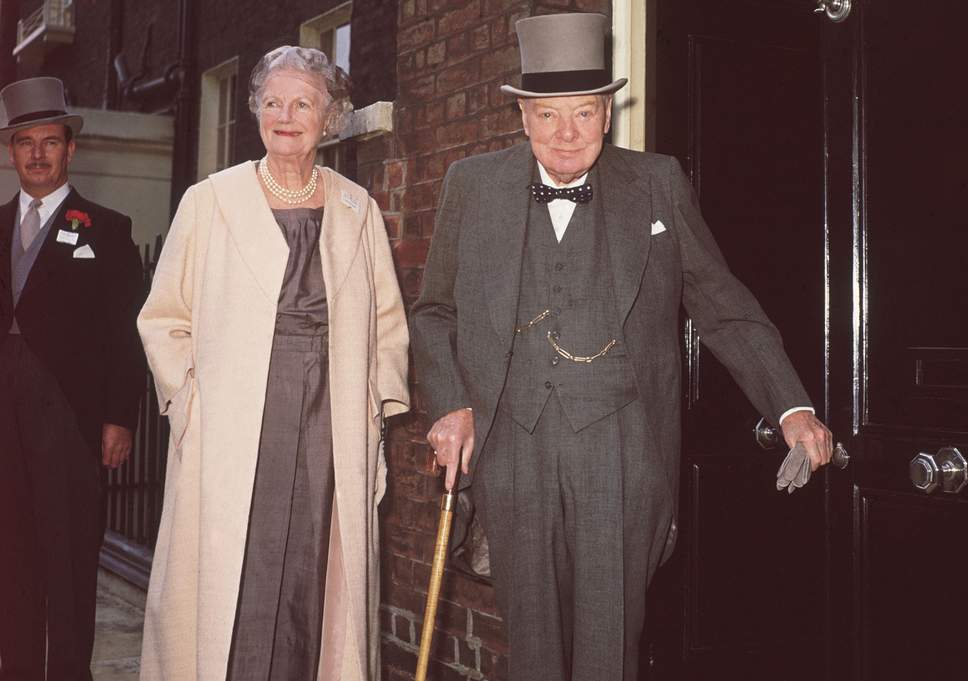
Murray watches over the Churchills
May 30, 2019
Finest Hour 183, First Quarter 2019
Page 16
By Fred Glueckstein
Fred Glueckstein is author of Churchill and Colonist II (2014)
Watching Winston Churchill was no easy task. The use of personal bodyguards for Churchill began in 1921 and continued for the rest of his life. The story of the remarkable men who guarded him exemplifies courage and devotion that never wavered. Here follows a look at the two longest-serving bodyguards, Walter Thompson and Edmund Murray, and two others of notable interest, Bill Day and Neville Bullock.
WALTER H. THOMPSON
On 9 November 1920, the Director of Intelligence at Scotland Yard told Churchill, then a Liberal MP and the Secretary of State for War and Air, that a Sinn Fein cell in Glasgow had decided there should be kidnapping reprisals in Britain for reprisals in Ireland. Among those to be kidnapped were Churchill and Prime Minister David Lloyd George. Churchill was warned not to go to Scotland “for the next few days or weeks” and provided temporarily with a personal armed bodyguard, Walter Henry Thompson. Thompson’s temporary appointment lasted the next nine and a half years. After a gap of ten years, however, Thompson was recalled from his retirement in 1939 to protect Churchill again, serving with him for another six years until the war ended.
First Meeting
Thompson, a Detective Sergeant of the Special Branch at Scotland Yard, first called upon Churchill at the Cabinet minister’s house in Sussex Square in early February 1921 to discuss what would be their “routine.” By the end of an extremely satisfying talk, Churchill said: “Thank you very much Thompson. I have no doubt that we shall get on well together.”1

2025 International Churchill Conference
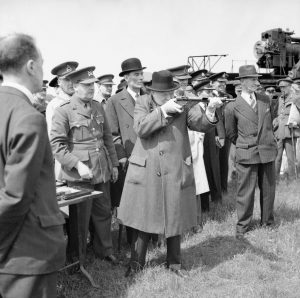
Developed out of necessity, the Sten was a submachine gun that was cheap and easy to produce but described by Sir Max Hastings as “highly unreliable, prone to jamming, and inaccurate beyond 30 metres.”
Soon after joining Churchill’s staff, Thompson’s importance as his bodyguard became apparent. Churchill, in his capacity as Air Minister, left for Egypt on 21 February 1921 to inspect units of the Royal Air Force. Thompson accompanied Churchill who was traveling with his Personal Secretary Sir Archibald Sinclair, his personal adviser T. E. Lawrence (of Arabia), and Chief of the Air Staff Lord Trenchard.
While in Cairo, Thompson was informed by the head of the Egyptian police that “Churchill is in the greatest danger. Trust nobody; black or white. Guard him to the exclusion of everything else.”2 After checking with Churchill that all was in order, Thompson told the hotel porter to report to him if anything in the slightest occurred. Thompson then returned to his room but within five minutes was informed that Churchill had left the hotel by himself on foot.
“Churchill was on his way to see General Allenby [High Commissioner for Egypt], heedless of the extreme danger he was in. I caught him up on the way. I had been frightened. Now I was angry,” wrote Thompson. “I said, all in a burst, ‘We can’t have this, sir. I can’t guard you if you treat me like this, sir. I’ve a great responsibility, and you are making my job quite impossible.’”3
Thompson waited uneasily for Churchill’s reply, which, “when it came, was the soft answer that turneth away wrath. ‘I will do all that I can to help you, Thompson. We’re just beginning to understand each other.’”4
As the English were unpopular in Egypt, Thompson wrote of “numerous ugly incidents” while there, including him and an RAF sergeant fighting off a mob that surrounded Churchill’s car. While he was leaving Alexandria, crowds of angry men stoned Churchill’s train and smashed every window. Thompson attempted to fight off men trying to enter the carriage with the butt of his gun, but he was overcome. Only when Lawrence appeared wearing Arab robes at the door of Churchill’s carriage and raising his hand did the crowd “gasp” and the riot end.
Sinn Fein Strikes
On 22 June 1922, Sir Henry Wilson, chief of the British General Staff, was assassinated by two IRA gunmen while returning home from unveiling a war memorial at Liverpool Street station. “For some weeks Churchill lived like a prisoner in a fortress. I was the senior officer responsible for his safety, and it was a nerve-racking time.” “Plain clothes men patrolled Sussex Square day and night, and when we went out, it was in an armoured Rolls Royce. The car was preceded and followed by Special Branch men, expert marksmen, on motorcycles. Sinn Fein meant business and our lives were in danger all the time,” wrote Thompson.5
Churchill did not always take Thompson’s concern regarding potential security risks seriously. One day, Churchill told Thompson he proposed to walk from the Colonial Office to the House of Commons. “I pointed out to him the dangers of this procedure, particularly as there was no other competent person [two Scotland Yard officers always attended Churchill] available to go with him at the time. My remarks had no effect at all. Mr. Churchill just shot out his chin in that obstinate way of his, and replied, ‘Righto, you look after my back, Thompson. I’ll attend to the front.’ We reached the House without mishap, but even now I can feel my hand gripping my revolver all the way.”6
From 1924 to 1929, Churchill was Chancellor of the Exchequer in the Baldwin Government. Normally, Thompson carried Churchill’s documents when he walked over to the House of Commons, but not on Budget Days. “Once I asked him if he would like him to carry the little dispatch box for him but he would have none of it. ‘No, Thompson,’ he replied. ‘There’s only one proper person to guard this box: that is me. You guard me.’”7
With the defeat of the Baldwin Government in 1929, Churchill ceased to be Chancellor of the Exchequer, and Thompson ended his duty as bodyguard since statesmen out of office were not entitled to Scotland Yard protection.8 It pained Thompson to leave Churchill, who expressed great regret that Thompson would no longer be with him. As it turned out, however, the separation was only temporary.
In November 1931, Thompson was informed at Scotland Yard that he was earmarked for a special assignment. He learned that Churchill had asked that he accompany him on a lecture tour to the United States and Canada. The reason was that certain Indian terrorist organizations had made threats against Churchill’s personal safety.
Five years after his temporary duty assignment, Thompson retired from the Metropolitan Police in 1936. He and his wife Kate bought a grocer’s store in South London and settled into the quiet “Churchill-free” life she had always imagined.
Telegram Arrives
Three years after retiring from the Special Branch, Thompson received an unusual order by telegram on 22 August 1939: MEET ME CROYDON AERODROME 4.30 PM WEDNESDAY CHURCHILL.
“I was at Croydon aerodrome the next afternoon, full of excitement and curiosity,” wrote Thompson. “The Paris plane came in, and out bounded Mr. Churchill. He was looking fit and full of energy as usual, but his expression was grim. He smiled when he saw me. I waited for some explanation of the summons. But all he said was, “Hello Thompson. Nice to see you. Get the baggage together and bring it to Chartwell.”8
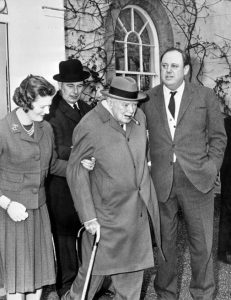
Churchill’s explanation to Thompson that afternoon was to the point: “The Germans believe I am one of their most formidable enemies. They will not stop short of assassination. I can look after myself in the daytime. Will you protect me at night?”9 Thompson quickly agreed. “What greater honour could be bestowed upon me than to be asked to make myself responsible for the personal safety of this great man, at a time when so much depended upon his maintaining his strength and vigour?” wrote Thompson”10 Within a fortnight, Churchill was back in the Cabinet as First Lord of the Admiralty, and Thompson found himself “unretired” for the duration.
After Churchill became Prime Minister in 1940, Thompson’s chief concern centered on two assassination possibilities: either an attempt by commandos or a targeted air raid on Chequers by fighter-bombers. Thompson took actions that helped protect Churchill from both possible assassinations.11
For his service in the protection of Churchill, Thompson was awarded the British Empire Medal by King George VI in the 1943 Birthday Honours list. After guarding Churchill through the entire war, Thompson retired for good in 1945. He wrote three books about his time with the British Prime minister and died at the age of eighty-seven on 18 January 1978.
On 4 September 1950, a police car raced out of Scotland Yard and across Westminster Bridge. Alongside the driver was Sgt. Edmund Murray of the Special Branch. In Murray’s jacket pocket was a newly issued Webley Scott pistol. The police car’s destination was Chartwell. Murray had just been assigned to be Churchill’s new personal bodyguard.
Upon arriving at Chartwell, Murray was met by Sgt. Williams, a Scotland Yard colleague already guarding Churchill. Williams introduced Murray: “Mr. Churchill moved his cigar to his left hand. I took his extended right lightly in mine, taking care, as I had been warned, to avoid clasping it too firmly. It was a warning I was to give in future years to hundreds of people, distinguished and humble alike. The great man shook my hand, inspected me carefully. ‘So you are Sergeant Murray. I trust that we shall get on well together for I have heard much about you. You have had a most interesting life…and I hear you even paint in oils.’”12
A Most Interesting Life
Thirteen years earlier in May 1937, Edmund Murray, at the age of nineteen, joined the French Foreign Legion and served in Indochina during the war fighting the Japanese. Murray wrote of the Legionnaires’ courage he witnessed: “They had all sworn never to fail; their sacred device [motto] was HONOUR AND FIDELITY.”13
At the end of his service contract with the Legion, Murray desired to continue fighting the Japanese and flew to Kunming, China. There, he went to the British Military Mission and accepted a commission as a civilian officer with a “clandestine intelligence organization.”
Murray was sent from Kunming to Calcutta, where he replaced the Officer in Command of a training camp for agents who were to be dropped behind enemy lines in Burma and Malaya. When the war ended, Murray returned to England.
In 1947, Murray was accepted into the Metropolitan Police Force and assigned to Golders Green police station. After eighteen months as a uniformed policeman, Murray was accepted to Scotland Yard’s Special Branch as a Detective-Constable.
In late August 1950, Murray was summoned to the Chief Superintendent, who informed him that he been assigned to protect Churchill. This temporary assignment lasted for nearly fifteen years, until the end of Churchill’s life.
Guarding Churchill
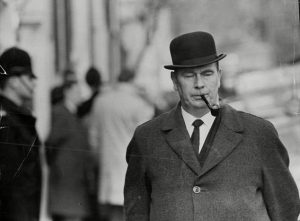
In October 1950, Murray accompanied Churchill to Denmark, where the statesman received a number of awards. A crowd of about one hundred thousand turned out to greet Churchill’s progress from Kastrup Airport to the City Hall. Among the crowd were Communists who disapproved of Churchill. Murray was soon involved in his first potential threat.
“It was from this group that I received the one uneasy moment of the trip. The car in which I was travelling with two Danish security men was an exact duplicate of the one in which Mr Churchill was riding. Our car led the way, a device designed for trouble-makers. Suddenly a small object with sparks shooting from it flew in a lazy arc above the heads of the crowd to land immediately beneath our car. There was an instant of icy uncertainty, then a loud explosion came from beneath the car … and nothing else except volumes of evil-smelling smoke. It was only a firework thrown by one of the Commies.”14
The trip to Denmark was the first of dozens of foreign trips that Churchill, accompanied by Murray, would embark upon. “The trouble with being on protection,” Murray recalled in his memoirs, “is that you are there more or less all the time and you are aware of so much that goes on that really has nothing to do with protection duties. Yet a protection officer has to keep his eyes open all the time and use his retentive mind to remember everything he sees.”15
Shared Love of Painting
While in Marrakesh, Murray was first assigned a role as “official photographer to Churchill the artist.” Using a Leica camera, Murray would take photographs of a scene that Churchill was painting. Should Churchill leave the scene due to bad weather, meals or summoned back to London, he would be able to complete the painting in the studio or hotel room.
Like Churchill, Murray was an amateur painter, and the two developed a solid friendship due to their love of painting. Churchill often maintained that Murray’s work was better than his.16
After Churchill’s passing on 24 January 1965, Reuters reported on Murray: “Sir Winston Churchill’s bodyguard for the last 14 years, Detective-Sgt. Edmund Murray, 47, will retire from the police force this week-end. He is planning a painting holiday in southern France. The destination has not been fixed, but is likely to be a spot on the Mediterranean coast at which the British elder statesman himself used to spend many days of his retirement painting.”17
BILL DAY
As a Royal Marine and bodyguard, Bill Day accompanied Churchill to the Tehran Conference in November-December 1943. The Conference was a strategy meeting between Churchill, Joseph Stalin, and Franklin D. Roosevelt to discuss opening a second front in the war.
Bill Day was on duty to protect Churchill and to safeguard the Sword of Stalingrad, a bejeweled ceremonial longsword designed by King George VI. The sword was made as a token of tribute from the British people to the Soviet defenders of the city during the Battle of Stalingrad. It was presented from Churchill to Stalin, with Roosevelt in attendance.
Bill Day had joined the Royal Marines in 1934. When the war began, he was promoted from corporal to sergeant. Day immediately volunteered for combat, which led to commando training in demolition, parachuting, glider insertion, and silent killing.
Day came to Churchill’s attention when the 40 Commando, Royal Marines, took part in the abortive Dieppe raid in 1942 that saw 60% of the main Canadian force killed or captured. After landing, the Royal Marines neutralized a battery of big guns on high ground and successfully withdrew.
After serving as Churchill’s bodyguard at the 1943 Tehran Conference, Day participated in the D-Day landings. As a Company Sergeant Major, he led 30 Assault Unit up Utah Beach. Later, Day took part in a successful mission to capture an experimental submarine, which used hydrogen technology, at the naval base in Kiel. Bill Day finished the war in Stettin, Poland, helping to liberate Stalag XI B, a prisoner of war camp.
NEVILLE BULLOCK
Neville Bullock, a Royal Marine, was just nineteen when he accompanied Churchill as part of the Prime Minister’s official bodyguard on a secret assignment. It turned out to be the Potsdam Conference held in defeated Germany in July 1945.
In Finest Hour 145 [“Eyewitness to Potsdam”], Bullock wrote about his experience guarding Churchill during the Prime Minister’s meeting with Joseph Stalin and President Truman. He later explained why his story took so long to be told: “I was restricted by the Official Secrets Act from talking about it for many years after the war and that became a habit and 35 years went by with me saying nothing at all about it.”18
Bullock remembered being honored to be given the assignment: “My marine comrades were sent on interesting and sometimes dangerous assignments. What I was doing was nothing compared to others, but I was honored. Churchill was a mighty figure during the war and commanded a great deal of respect.”19
In 2015, Bullock spoke of the Potsdam Conference and Churchill: “I was there when he came out of that meeting at Potsdam. I went up to him as I was guarding and he turned and snarled at me. ‘Do you have to follow me everywhere?’ I explained I did.”
“He said, ‘You are a bloody nuisance’, then he looked at me and sighed and said, ‘Come on, I have been a bloody nuisance for years.’” As we walked away back to his villa he turned and said “There is a cold wind coming, and we shall need to keep warm.” Bullock added: “I got three pounds in an envelope the next day and I knew it had come from the Old Man, as we called him.”20
Endnotes
1. Walter Thompson, Beside the Bulldog: The Intimate Memoirs of Churchill’s Bodyguard (London: Apollo, 2003), p. 46. Note: The book reproduces in its entirety Thompson’s Sixty Minutes with Winston Churchill (London: Christopher Johnson, 1953).
2. Ibid., p. 47.
3. Ibid., pp. 47 and 49.
4. Ibid., p. 49.
5. Ibid., p. 56.
6. Ibid.
7. Ibid., p. 62.
8. An exception had been made for Churchill when he was out of office during the years 1922–24, because of the continued threat presented by Sinn Fein.
9. Thompson, p. 14.
10. Ibid., p. 15.
11. William Manchester and Paul Reid, The Last Lion: Winston Spencer Churchill, Defender of the Realm, 1940–1965 (Boston: Little Brown, 2012), pp. 194–95.
12. Edmund Murray, Churchill’s Bodyguard (London: W. H. Allen, 1988), p. 84.
13. Ibid., p. 47.
14. Ibid., p. 89.
15. Ibid., p. 132.
16. Ibid., pp. 99–100.
17. “Sir Winston’s Guard to Quit London Police,” Chicago Tribune, 28 February 1965, p. B8.
18. Maxwell Kelsey, “My Life as Churchill’s Bodyguard,” St. Helens Reporter, 19 January 2011, and “Bodyguard to Winston Churchill Dies Aged 92,” St. Helens Star, 23 August 2017.
19. Ibid.
20. Ibid.
Subscribe
WANT MORE?
Get the Churchill Bulletin delivered to your inbox once a month.

